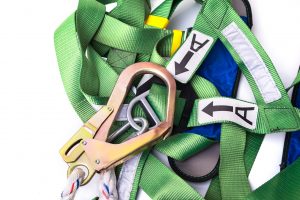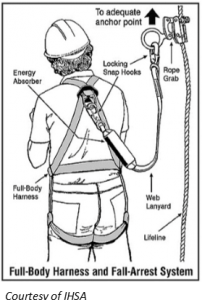
WORKING AT HEIGHTS – EQUIPMENT
Falls are a major cause of injuries and fatalities in Canada each year.
Most injuries and deaths occur because Personal Fall Protection Equipment was:
- not available,
- available but not used, or
- used, but not used properly
POST considers Work at Heights activity where worker’s feet are more than 1.8 metres above grade, floor or surface.
FALL PROTECTION EQUIPMENT
Examples of Personal Fall Protection Equipment
Harnesses: 5 Categories:
A=Fall Arrest;
The full body harness is used as a component of a personal fall arrest system. Personal fall arrest systems typically include a full body harness and a connecting subsystem (energy absorbing lanyard). Maximum arresting force must not exceed 1,800 lbs (8 kN). For fall arrest applications connect the fall arrest subsystem (example: lanyard, SRL, energy absorber, etc.) to the D-Ring or attachment element on your back, between your shoulder blades

D=Controlled Descent;
For controlled descent applications, harnesses equipped with a single sternal level D-ring, one or two frontal mounted D-rings, or a pair of connectors originating below the waist (such as a seat sling) may be used for connection to a descender or evacuation system (reference in Z259.10 in Canada).
E=Confined Space;
The full body harness is used as a component of a rescue system. Rescue systems are configured depending on the type of rescue. For limited access (confined space) applications, harnesses equipped with D-Rings on the shoulders may be used for entry and egress into confined spaces where worker profile is an issue.
L=Ladder use;
The full body harness is used as a component of a climbing system to prevent the user from falling when climbing a ladder or other climbing structure. Climbing systems typically include a full body harness, vertical cable or rail attached to the structure, and climbing sleeve. For ladder climbing applications, harnesses equipped with a frontal D-Ring in the sternal location may be used for fall arrest on fi xed ladder climbing systems. These are defined in CSA Z259.2.5 in Canada and ANSI A14.3 in the United States.
P=Work positioning
The full body harness is used as a component of a work positioning system to support the user at a work position. Work positioning systems typically include a full body harness, positioning lanyard, and a back-up personal fall arrest system. For work positioning applications, connect the work positioning subsystem (example: lanyard, Y-lanyard, etc.) to the lower (hip level) side or belt mounted work positioning attachment anchorage elements (D-rings). Never use these connection points for fall arrest.
 Lanyards: Shock Absorbing for Fall Arrest; Non-Shock Absorbing for travel restraint; Self-retracting
Lanyards: Shock Absorbing for Fall Arrest; Non-Shock Absorbing for travel restraint; Self-retracting
Lifelines: Vertical, Horizontal, Retractable or Static
Rope Grabs: Used in conjunction with Lifelines
Anchors: Must be engineered
INSPECTION OF EQUIPMENT
Workers must be able to properly inspect and identify deficiencies with the equipment and exercise their right-to-refuse to use sub-standard equipment as well as understanding their legal obligation to report the deficiencies.
Employers/Supervisors are prohibited from threatening or dismissing a worker for exercising these rights.
Defective, Personal Fall Protection Equipment must be destroyed.
Some jurisdictions require certification to inspect equipment.
Relief Step Safety Device
Workers, who have been saved from a fall by use of a harness are susceptible to a condition known as Suspension Trauma.
If left hanging for more than a few minutes, blood pools in the legs resulting in loss of consciousness and if left for too long, it can result in death.
Post rescue death can also occur if the victim is laid down too soon…the heart cannot handle the rush of blood all at once. This stresses the importance of receiving the proper working at heights training.
To prevent suspension trauma, a Relief-Step Safety Device can be used.
The device attaches easily to any Full-body harness and allows the user to stand ensuring proper blood flow.

Relief Step Safety Device
FALL PROTECTION PLANS
Employers must develop a fall protection plan. Arresting a Fall is the main part, but not the only part, to ensure safety while working at heights.
A fall protection plan is a pre-planned strategy or procedure, designed to safely retrieve someone who has fallen from height and is suspended in a harness. It provides information about the type and location of equipment that are vital in the rescue process.
We have provided links to provinces that provide sample fall protection plans through their government and/or occupational health and safety websites. If your province is not listed, another provinces example can be used as a template to assist you in developing your own plan.
All plans should be developed to reflect the specific work you are doing. The templates provided should only be used as a guideline.
Visit the Fall Protection Plan templates page for more information.
Download a copy of this guideline
POST Best Practices – Working at Heights Equipment
To print, select two-sided printing and fold
